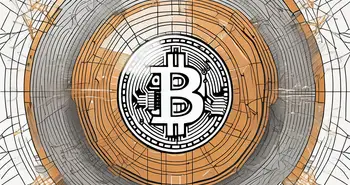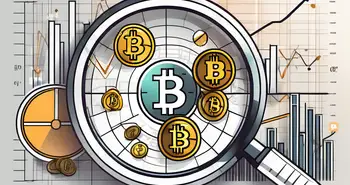Will Bitcoin Recover in 2023

The world of Bitcoin is a strange and unpredictable one, where memes and market forces collide in a chaotic dance of wealth and power. This article will try to make sense of it all and provide some insight into the future of the so-called digital gold. In this article, we'll take a deep dive into the history of Bitcoin, its current state, and whether or not it's likely to recover in 2023.
Overview of Bitcoin's history and previous market cycles
Bitcoin is a decentralized digital currency that operates on a peer-to-peer network without the need for a central authority. The network is secured by complex cryptography, making it resistant to fraud and hacking. Transactions on the Bitcoin network are verified and recorded on a public ledger called the blockchain, which makes the system transparent and immutable.
Bitcoin emerged on the scene in 2009, created by an unknown individual or group using the pseudonym Satoshi Nakamoto. Since then, it has gone through several boom and bust cycles. During the height of the Bitcoin craze, prices soared to unprecedented levels, reaching an all-time high of more than $65K in October 2021.
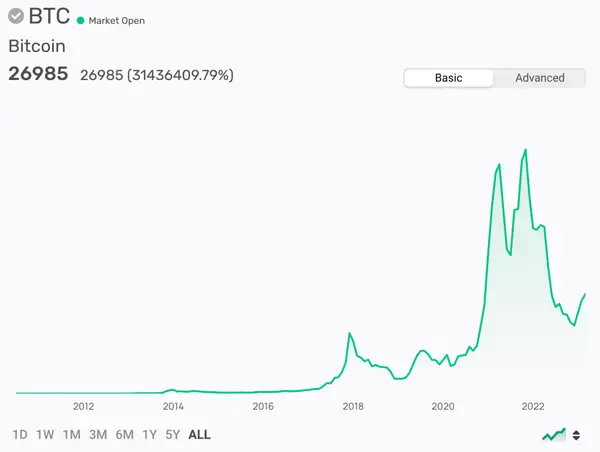
Bitcoin is multifaceted; some call it a meme, and some the hardest asset on the planet. Bitcoin was declared dead many times before. It is attacked and called names by central banks, famous investors, and even Greenpeace, calling it a “ponzi” or a “fugazi” if you like.
However, others see it as the only real alternative to the corrupt fiat banking system. Companies like Microstrategy are spending billions to buy more Bitcoin as a store of value, and some even make “public” bets that Bitcoin will reach $1 million by June 2023, with a promise to pay $1 million if it does not.
Despite the controversies and criticisms, Bitcoin has gained increasing recognition from institutional investors and financial institutions. In 2023, Goldman Sachs declared Bitcoin as the best-performing asset class, which is a testament to its growth potential and the increasing demand for digital assets. Bitcoin's market capitalization is comparable to countries' currencies like Sweden, Israel, or Indonesia. Proponents of Bitcoin argue that it offers a viable alternative to traditional “manipulated” fiat currency systems.
“By participating in the system of fiat debt slavery, you reinforce the meme of instant gratification, of discounting the future for the present, of fake money and short-term thinking. By participating in the bitcoin system, you reinforce the meme of sound money, inelastic supply, long-term thinking, responsibility, and inalienable property rights.”
Gigi, Bitcoin Maximalist
While there are multiple perspectives to consider when evaluating Bitcoin's price determinants, it is clear that the cryptocurrency has become a significant player in the global financial landscape, attracting both supporters and skeptics alike.
What Determines the Bitcoin Price?
Much like any other asset, Bitcoin's price is primarily determined by the interaction between its supply and demand. However, some argue that Bitcoin's intrinsic value lies in its unique combination of scarcity, cryptographic properties, and philosophical ideals.
Bitcoin's scarcity is a key driver of its value. With a hard cap of 21 million bitcoins, the supply is limited and cannot be increased beyond this predetermined amount. This starkly contrasts traditional fiat currencies that can be printed at will, leading to inflation and currency devaluation over time. Furthermore, Bitcoin's cryptographic properties provide a level of trust and security unparalleled in traditional financial systems. The immutable nature of the blockchain, combined with the decentralized nature of Bitcoin's network, creates an unbreakable chain of ownership and transaction history.
In addition, Bitcoin has come to embody a set of cultural and philosophical values, serving as the native money and meme of the internet that champions free speech, privacy, economic stability, and much more that would improve civilization.
This has attracted a growing number of individuals and institutions who seek to embrace these ideals and hedge against traditional financial systems that they view as corrupt, unstable, and pure slavery. This increasing demand and adoption has created a self-fulfilling value cycle as more individuals and institutions flock to Bitcoin, reinforcing its status as a legitimate asset class.
Will Bitcoin Go Back Up to 60K?
The million-dollar question on everyone's mind is whether or not Bitcoin will recover to its previous highs of around $60,000. While it's impossible to predict the future with certainty, several factors could contribute to a recovery.
- Institutional Adoption
The adoption of Bitcoin by institutions is one of the most significant developments in the cryptocurrency market in recent years. Major companies like Tesla, Square, and PayPal have already added Bitcoin to their balance sheets at some point or offered their customers the ability to transact in Bitcoin. However, despite these early adopters, Bitcoin is still primarily a retail asset. The cryptocurrency market is waiting for a massive wave of institutional adoption, as large asset managers and financial institutions recognize the potential of Bitcoin as a hedge against inflation and a store of value. Once institutional adoption begins in earnest, we can expect to see a significant shift in the market dynamics of Bitcoin as vast sums of institutional capital pour into the asset class.
- Bitcoin’s limited supply and halving events
Bitcoin's limited supply of 21 million coins is a fundamental characteristic that drives its price. This scarcity is ensured by a predetermined issuance schedule that halves roughly every four years, known as “Bitcoin halving events”.
Historically, there has been a significant increase in Bitcoin's price after each halving event. For instance, in 2012, the first halving event saw a price increase of over 8,000%. In 2016, the second halving event led to a more than 2,000% price surge. Similarly, in 2020, the third halving event preceded a bullish trend, resulting in the cryptocurrency's price more than quadrupling within a year.
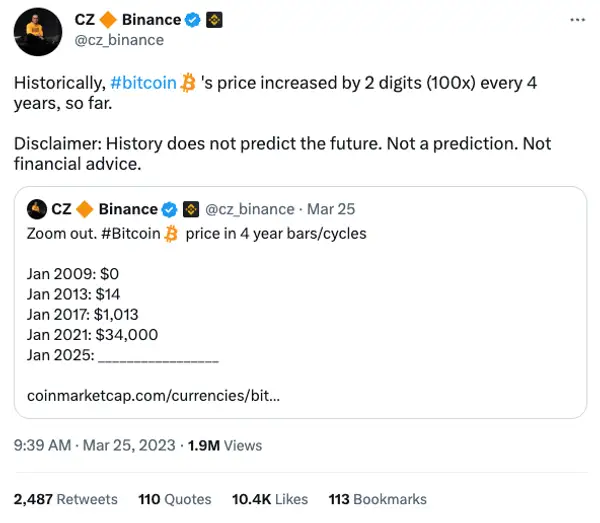
This predictable scarcity and the periodic halving events serve as a check on inflation and assure Bitcoin's users of its value proposition, driving up demand and, subsequently, the price.
- Mainstream Adoption
As of 2023, the adoption of Bitcoin and cryptocurrencies generally has seen significant growth. While retail investors were the early adopters of Bitcoin, the past few years have seen a surge in mainstream adoption. According to recent statistics, around 400 million people now own cryptocurrencies globally, a testament to the increasing acceptance of digital assets in the mainstream. This adoption can be attributed to the increasing ease of access to cryptocurrencies, with more and more financial institutions offering services related to digital assets.
- Countries Adoption
The adoption of Bitcoin by countries has been a slow but steady process. While some countries have been hesitant to embrace digital currencies, others have taken bold steps toward integrating them into their economies. El Salvador made history by becoming the first country to adopt Bitcoin as a legal tender in 2021, and other countries are now following suit.
Moreover, countries have always held big amounts of gold reserves and may begin to shift towards Bitcoin as a digital alternative to traditional gold. Bitcoin might be an attractive alternative for countries looking to diversify their reserve assets. The 21st century belongs to the internet, and Bitcoin is poised to be a part of that future.

- Regulatory Factors
The regulatory environment plays a critical role in adopting Bitcoin and varies significantly across countries. Some jurisdictions, like UAE, are positioning themselves as crypto freezone to attract investments and innovation. Meanwhile, other governments, such as China, have taken a harsher stance, banning cryptocurrencies outright and imposing strict penalties for their use. In the United States, there is speculation that the government may launch Operation Chokepoint 2.0 to curtail the use of cryptocurrencies after the recent banking crisis. Despite the varying regulatory environments, it is important to note that Bitcoin's decentralized nature makes it challenging for any single government or institution to control or ban outright and regulations that are more adopting will attract companies.
What Could Cause Bitcoin to Recover Again
Aside from institutional adoption and the limited supply of Bitcoin, other factors could contribute to a recovery in 2023. One of these is increased mainstream acceptance, as more people become aware of and comfortable with the idea of digital currencies.
Another factor is the ongoing geopolitical tensions and economic uncertainty that could push investors towards alternative assets such as Bitcoin. In times of crisis, people tend to seek out safe havens for their money, and Bitcoin could potentially fill that role.
The BitSignal was put up on March 16, 2023, by Balaji Srinivasan to alarm the public and to show that Bitcoin is the best alternative to the USD that, is losing the reserve currency status against the Chinese RMB. Balajis tweet got over 5 Million views, so perhaps that will be the start of Bitcoins price recovery.
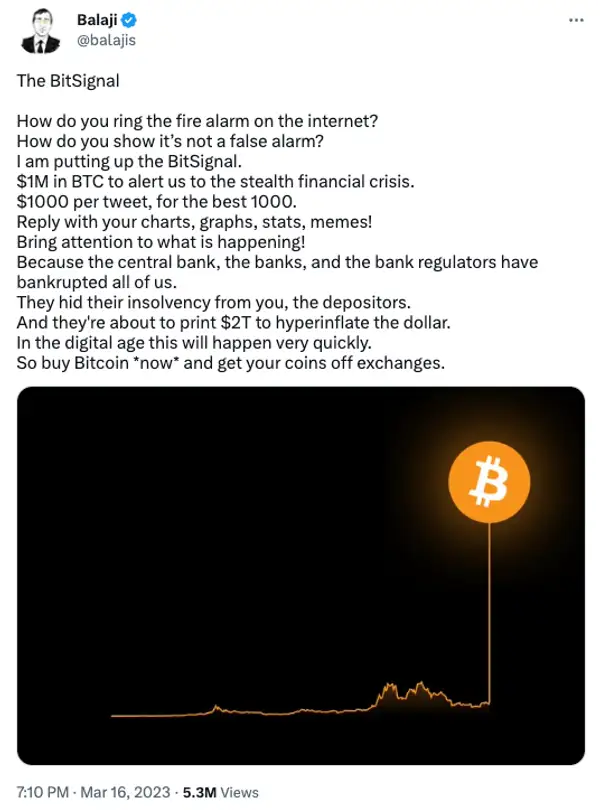
Conclusion
In conclusion, the future of Bitcoin is far from certain. While it's experienced several boom and bust cycles, it's impossible to predict whether or not it will recover in 2023. However, several factors could contribute to a rise in prices, including institutional adoption, limited supply, increased mainstream acceptance, and economic uncertainty. For what it’s worth, send the BitSignal and give people hope for Bitcoin to unlock its full potential.

Disclaimer: All investments involve risk, and the past performance of a security, industry, sector, market, financial product, trading strategy, or individual’s trading does not guarantee future results or returns. Investors are fully responsible for any investment decisions they make. Such decisions should be based solely on an evaluation of their financial circumstances, investment objectives, risk tolerance, and liquidity needs. This post does not constitute investment advice.

Painless trading for everyone
Hundreds of markets all in one place - Apple, Bitcoin, Gold, Watches, NFTs, Sneakers and so much more.

Painless trading for everyone
Hundreds of markets all in one place - Apple, Bitcoin, Gold, Watches, NFTs, Sneakers and so much more.

